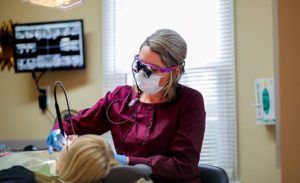5 REASONS PEOPLE AVOID THE DENTIST
October 23, 2023
 There are five major reasons that people do not get the necessary dental care they need; six if you count the recent pandemic. The other five are money, time, lack of concern, fear and trust. Let’s take a quick look at each one and see if any of them fit you, and what dentists often try to do to overcome these obstacles for patients.
There are five major reasons that people do not get the necessary dental care they need; six if you count the recent pandemic. The other five are money, time, lack of concern, fear and trust. Let’s take a quick look at each one and see if any of them fit you, and what dentists often try to do to overcome these obstacles for patients.
Although you may think that money would be the number one reason people avoid ideal dental treatment, it is not. Even in tougher economic times, money, although a significant barrier for many, is still not the number one issue for most. Dental health, and good health in general, always requires some kind of investment.
Lack of dental insurance is a poor excuse for not getting regular dental maintenance. As I have said numerous times, dental insurance in not insurance; it is a benefit. If it were “insurance”, it would cover treatment that patients need. While not bad to have, the advantage is limited, based on insurance company’s unwillingness to raise the bar and change a system that hasn’t changed since the 1970’s.
Unfortunately, as of now, we have to face these facts, and it does not mean avoiding the dentist. Many dentists offer in-office payment plans, as well as plans through third party carriers, so patients can finance needed treatment. Two dental hygiene appointments a year costs way less than many other things people spend money on. If you drive your car for 20,000 miles without maintenance, something is bound to happen. The better you take care of your car, the less problems you’ll have.
Time is another excuse. We all use time as an excuse for many of the things in our lives we want to avoid or procrastinate on. The reality is, however, if we place something high enough in our value system, there is always time for it. In order to move something higher up in our value system, we must be enlightened enough to realize that this particular thing is of benefit to us. This brings me to the most common reason people avoid ideal dental care.
Lack of concern about dental health is prevalent with a large percentage of the population. Absence of pain is the biggest reason for this lack of concern. Other than a severe toothache and need for a root canal or extraction, there are few things that cause enough pain to bring someone to the dental office. Take gum disease; about 75% of the population has some form of this disease, but only 50% of the population goes to the dentist. Why? No pain. Absence of pain is a poor indicator of health.
Some people have fear about going to the dentist….and for good reason, due to bad past experiences or bad information. However, dentistry today should be a comfortable experience most of the time. For those that are still fearful, there are different medications dentists can use to ease the experience.
The last barrier to ideal treatment is trust. For a patient to move forward with treatment, it is essential the patient both like and trust the dentist. Although I am sure that the skills of your dentist are important to you, I am willing to bet that you would not stay with a dentist who you did not like or trust. Find someone you can connect with and build a strong doctor-patient relationship.
I believe that one of the best things a patient can do for their dental health is to find an office they like and trust……and stay there. Continuity of care is in the patient’s best interest. Find your dental home.
Dr. St. Clair maintains a private dental practice in Rowley dedicated to health-centered family dentistry. He has a special interest in treating snoring, sleep apnea and TMJ problems. If there are certain topics you would like to see written about or questions you have please email them to him at jpstclair@stclairdmd.com
BETTER THAN FLOSS
October 16, 2023
The two things you’re supposed to do to clean your teeth: Brush & Floss. Any of you have your hygienist get on your case about not flossing? You may be the best brusher in the world, but if you’re not cleaning between your teeth, we know it. Cleaning between the teeth is essential for good oral health, AND good overall health.
To reiterate, we need to think about brushable surfaces vs. non-brushable surfaces in the mouth. Floss, which is basically a piece of string, is great after eating corn-on-the-cob. Other than that, using an oral irrigator (water flosser), is much better at cleaning the non-brushable areas in the mouth.
Clinically, we usually see significant improvement in patients who add oral irrigation to their homecare routine. However, if you look at the research available, it is weak, just like that for flossing. There are just not a lot of studies that have been done. But anecdotally, I can tell you it is a game-changer for many.
The Waterpik® packaging says that oral irrigation is 3X more effective than floss. These claims are from “independent” studies; basically, their own research. While floss can be effective for some, many people get much better results with oral irrigation. Disease starts in the areas that you cannot brush. Brushing alone is not enough for anyone. A jet stream of water is great at disrupting the millions of bacteria living under your gumline.
Stimulation of the gum tissue is essential to a healthy mouth. Oral irrigators do a great job of this. Like anything else, it takes a little getting used to. It takes a little time to build up tolerance and be able to increase the pressure of the stream of water. Once you get used to it, it seems to be very effective in stimulating healthy tissue.
Oral irrigators are essential for both kids and adults with braces. They are also great for those with crowns, bridges, larger spaces between the teeth, people battling periodontal disease, or anyone trying to achieve healthier gums. The units come with an assortment of tips for different applications.
There are both counter models and cordless hand-held models. The counter models have a wider range of pressure settings and a larger tank to hold water. The cordless models are very convenient for obvious reasons but the water compartment is very small. You typically have to fill it up about four times for each use. I prefer the counter-top models.
Here is the bottom line. If you brush and floss impeccably, and your dentist or hygienist says your gum tissue is as healthy as it could be, a “water flosser” is a tougher sell to add to the routine. In my experience, that is a very small portion of the population. Most people have room for improvement with their homecare.
The newest independent research I have seen, which was not done by a product manufacturer, shows that using a water flosser is significantly better than brushing alone. So, if you don’t floss, have braces, have any type of implants, any crowns, bridges, or veneers, have diabetes, or have been told you have gingivitis or any other type of periodontal disease, this product will most likely improve the report you get when you visit the dental office.
Like anything, compliance is the key. Research shows that only 2-10% of the population flosses regularly and effectively. The average brushing time is 37 seconds, as opposed to the recommended 2 minutes. Improvement comes with the effective use of the tools you have. An oral irrigator is a giant step to a healthier mouth!
Dr. St. Clair maintains a private dental practice in Rowley dedicated to health-centered family dentistry. He has a special interest in treating snoring, sleep apnea and TMJ problems. If there are certain topics you would like to see written about or questions you have please email them to him at 
TMJ Awareness Month: Recognizing and Treating TMJ Disorder
October 13, 2023
 There are roughly 10 million people in the United States who have a TMJ disorder. This condition can cause quite a bit of discomfort, but it can typically be managed with the right steps. Since November is TMJ Awareness Month, now is a good time to become more familiar with the warning signs of TMJ disorder as well as how it can be treated; that way, you can make sure that you’re well-prepared when it comes to keeping this potentially painful problem under control. (more…)
There are roughly 10 million people in the United States who have a TMJ disorder. This condition can cause quite a bit of discomfort, but it can typically be managed with the right steps. Since November is TMJ Awareness Month, now is a good time to become more familiar with the warning signs of TMJ disorder as well as how it can be treated; that way, you can make sure that you’re well-prepared when it comes to keeping this potentially painful problem under control. (more…)
THE CLEAR CHOICE
October 10, 2023
 I have focused the majority of my career on family preventive and general dentistry. While I enjoy most aspects of what I do, I firmly believe that a good percentage of dental problems are avoidable, which means that dentists shouldn’t be as busy as we are with routine fillings, removal of teeth, and many other procedures. While there are other factors at play, such as genetics, personal responsibility is often at the head of the pack.
I have focused the majority of my career on family preventive and general dentistry. While I enjoy most aspects of what I do, I firmly believe that a good percentage of dental problems are avoidable, which means that dentists shouldn’t be as busy as we are with routine fillings, removal of teeth, and many other procedures. While there are other factors at play, such as genetics, personal responsibility is often at the head of the pack.
Prevention often takes a back seat to fixing problems. Decayed, broken and worn teeth all had nothing wrong with them at some point. Granted, you have to fix what is already broken, but “How could it have been prevented?” has always been the question I ask myself, and try to make my patients understand.
What are the factors at play for the 6 new cavities? What could have been done to avoid the wearing-down of all the teeth? Could anything have been done during growth to alter how the airway develops? What factors are causing the chemical erosion of the teeth? These are important questions to be considered.
Much of what is being marketed to dentists today is technology; 20 years ago, it was cosmetics. The technology available today in dentistry is really cool, just like the technology available in most other areas of our lives. There are some things I would not want to live without since adding them to our office; digital x-rays, digital scanning instead of messy impressions, computer-generated restorations, telemedicine, etc. However, how much technology do we really need if we avoid the problems in the first place?
Let me give an example. If I had to pick the single most important “technology” that has impacted dentistry in the last 30 years, it would be dental implants. Grafting of bone and dental implants have changed the lives of many people, who would otherwise have been forced to wear something removable in their mouth to replace teeth. And, while this is a great service to patients, I’m still always thinking, “What are the lessons I have learned to help my next patient avoid needing all this dentistry?”
More dentists are being trained to place dental implants, not only to replace one missing tooth, but to replace ALL the teeth. You may have seen the commercials from a large dental franchise with stories from “real” patients who have had dental implants change their lives. What they don’t tell you is that they remove all the teeth, even ones that can be saved, remove a ton of bone to be able to place 4-6 dental implants, to then have a piece of plastic with plastic teeth screwed to it. They claim – “You can put an end to dealing with missing teeth or repetitive dental work with dental implants.”
You have to go in for the consultation to find out that upper and lower “All-on-4” dentures attached to implants will run you $60K+. They also fail to mention in any of the advertising that there is maintenance that can be costly. And, they don’t really feel like teeth. While this treatment may be acceptable for some patients, the clear choice, is to avoid it.
Keeping your natural teeth makes much more sense. Improving and maintaining any part of our health requires time, commitment and resources. There are many great dentists out there to help you maintain your teeth for a lifetime.
Dr. St. Clair maintains a private dental practice in Rowley dedicated to health-centered family dentistry. He has a special interest in treating snoring, sleep apnea and TMJ problems. If there are certain topics you would like to see written about or questions you have please email them to him at jpstclair@stclairdmd.com
WHAT ARE YOUR DENTAL OBJECTIVES?
October 2, 2023
 Let’s use this hypothetical situation: You have not been to a dentist in a while (pick a time frame), you are well aware you need some dental work, you were given the recommendation of a dentist by a friend…..and, you decide to visit that dentist and four other dentists to compare and make a decision who is the best fit for you. (I realize that most people don’t want to and/or don’t have the time to visit five dentists….but play along).
Let’s use this hypothetical situation: You have not been to a dentist in a while (pick a time frame), you are well aware you need some dental work, you were given the recommendation of a dentist by a friend…..and, you decide to visit that dentist and four other dentists to compare and make a decision who is the best fit for you. (I realize that most people don’t want to and/or don’t have the time to visit five dentists….but play along).
You already have an idea of what you are looking for. It might be the dentist who says you need the least. It might be the dentist who is the cheapest. It might be the dentist who is closest to where you live. It might be the dentist who gives you the most options, or maybe the least. It might be the dentist who listens to you the best. Be prepared, because you are likely to hear a few different styles/opinions visiting five dentists.
Some practices may feel “clinical and efficient”, while others feel somewhat more home spun and laid back. The dentist’s personality and experience are reflected in his or her treatment preferences as well. The fact that different dentists will suggest different plans to treat your condition does not necessarily mean that one plan is better than another. Have an open mind and play an active role in the treatment planning process.
It is important to remember that there are numerous ways to treat the same situation, and it is always important for the dentist to tailor the treatment plan for each patient’s specific circumstances. A major part of those circumstances may be financial, and since different treatment plans can vary a great deal in cost, it is important for the dentist to discuss costs and options for payment.
Think of treatment plans like various models of cars offered by different dealers. All of the models are new, have warranties and will work well out of the lot. The higher end models, however, have some advantages not found in the less expensive models. Some options add years to the life of the car. Some add to the appearance and enjoyment of driving it. Having said that, dentistry is not a commodity. There are many factors that need to be taken into consideration when choosing your provider or the treatment you choose for yourself.
What makes sense for you? What are your objectives? Saving a badly damaged tooth with a root canal and a crown may preserve it for a long time, but what are the circumstances of how the tooth got to that point? If you haven’t been to a dentist in many years and have many other dental needs, does it make sense?
We have so many great dental providers in our area. Think about what you are looking for in a dental care team Read that list in the second paragraph again.
The focus should be on long-term objectives and prevention. If you are a regular dentist-goer and have a dentist you like, you’re all set. If you haven’t been in a while, consider making the decision to change how you look at your dental health. Start with finding a place that fits your particular needs, and make the commitment to make routine preventive dental care part of your life.
Dr. St. Clair maintains a private dental practice in Rowley dedicated to health-centered family dentistry. He has a special interest in treating snoring, sleep apnea and TMJ problems. If there are certain topics you would like to see written about or questions you have please email them to him at jpstclair@stclairdmd.com
Can Having Nightmares Be a Symptom of Sleep Apnea?
September 26, 2023
 Sleep apnea can have many side effects that you may not be aware of. One example is the impact it can have on your dreams. Some people with sleep apnea find that they don’t dream at all, but others might start experiencing particularly vivid nightmares. Your dentist is here to explain more about the relationship between sleep apnea and nightmares – as well as what you can do to improve your dreams.
Sleep apnea can have many side effects that you may not be aware of. One example is the impact it can have on your dreams. Some people with sleep apnea find that they don’t dream at all, but others might start experiencing particularly vivid nightmares. Your dentist is here to explain more about the relationship between sleep apnea and nightmares – as well as what you can do to improve your dreams.
OTHER OPINIONS
September 25, 2023
 It is not uncommon to get a second opinion, or a second or third quote for things like car repairs and home improvements. When it comes to our health, it usually depends on the nature of the issue. More complex issues in medicine, such as a diagnosis of cancer, an unknown diagnosis, or other major medical issues in which we have to make decisions about significant treatment, tend to stimulate people to get more than one opinion. In dentistry, it seems that the incidence of second opinions is not as great.
It is not uncommon to get a second opinion, or a second or third quote for things like car repairs and home improvements. When it comes to our health, it usually depends on the nature of the issue. More complex issues in medicine, such as a diagnosis of cancer, an unknown diagnosis, or other major medical issues in which we have to make decisions about significant treatment, tend to stimulate people to get more than one opinion. In dentistry, it seems that the incidence of second opinions is not as great.
Routine dental care is generally not that complicated. There are many different ways to do the simplest things in dentistry. The method is a function of the dentist’s beliefs and training. It is relatively uncommon for a patient to get a second opinion for this type of maintenance dental care. Although there is some subjectivity as to what different dentists might deem as “needing” to be done, patients usually base their decision on their perceived need. This perception of need comes from the dentist’s ability to communicate the reasons for treatment.
The patient’s trust in their provider is a big factor. If a patient trusts and genuinely likes their dentist, they may not necessarily do or want to do what the dentist wants them to, but they are comfortable enough to make the decision on treatment. It is when there is a lack of trust, for one reason or another, that patients tend to venture out for another opinion. This lack of trust usually stems from a personality conflict or the inability of the dentist to properly communicate with the patient effectively.
Even when there are more complex dental issues, it is my feeling that patients base the need for another opinion on lack of trust. Another important factor is that the patient is given choices. Patients always have the right to choose what treatment they feel is right for themselves. If choices are given and the treatment is properly communicated to the patient, they have the ability to decide in what direction to proceed.
If a dentist properly communicates the need for treatment and the patient decides to do nothing, it is the patient’s choice. It is when treatment is properly presented and it aligns with the patient’s perception of need or desire, that the patient moves forward with treatment.
Fees tend to be a less common reason for patients to seek another opinion. Fees for treatment can definitely vary. The problem with seeking treatment based on fees is that the same treatment in two different offices with different fees can also vary in the level of expertise and precision in which it is done. There are many factors.
A higher fee does not always mean a higher quality product. Fees are generally based on the time involved, the materials used, and the perceived expertise of the provider. Be cautious when seeking treatment based on fees. The fee for treatment should definitely be considered, but the entire treatment presentation and the way in which it is communicated should be used to determine your decision.
Dr. St. Clair maintains a private dental practice in Rowley dedicated to health-centered family dentistry. He has a special interest in treating snoring, sleep apnea and TMJ problems. If there are certain topics you would like to see written about or questions you have please email them to him at jpstclair@stclairdmd.com
THE DAILY GRIND
September 18, 2023
Studies have shown a link between teeth grinding, clenching and headaches. There are also links to people who have sleep breathing disorders, and those who take serotonin uptake inhibitors (SSRI). Some brand names of these drugs are Celexa, Lexapro, Prozac, Paxil and Zoloft. Many people grind and clench their teeth for many different reasons – let’s not forget STRESS!
For people who grind or clench, the muscles that open and close the jaw can become painful from overuse, causing a range of symptoms from tension to migraine headaches to jaw joint (TMJ) problems to tooth pain. Here is a simple test – look at your tongue in the mirror without sticking it out. Are the borders smooth? If they are ridged, you are probably doing something outside of normal function.
Bruxing (grinding) and clenching teeth is defined as abnormal tooth contact (parafunction). Ordinarily, teeth should only be in contact while eating and swallowing, which is about 10 to 15 minutes on a daily basis. People who grind or clench their teeth during the day, or while sleeping, can have their teeth in contact for as much as six hours a day or more. Researchers say that one night of grinding is equivalent to 80 days of normal wear. Read that last sentence again.
Clenching can be just as bad, and in some cases, worse than grinding. The average person puts about 200 lbs. of force on back molars during function, but a person who clenches can put up to 1000 lbs. on the molars. This is a lot of force for the teeth to withstand. Fractured teeth are seen on a regular basis in dental offices due to clenching. Typically, a person will come in saying that their tooth broke while they were eating something soft. While that may be the case, often times clenching and/or grinding has weakened the tooth prior to it breaking.
The American Dental Association estimates that 95 % of the American population suffers from a grinding or clenching problem at some point in their lives. Some people do so much damage over time that they need a lot of dentistry to restore their teeth back to normal function. The key is early diagnosis and treatment.
Many patients do not realize, and some refuse to accept the fact that there is a problem. The reason for this is because many, if not most, do not have symptoms. The masticatory system is a very adaptive and forgiving system. Some even think their symptoms are just normal. However, if a problem is identified, accepted, and treated, it can help prevent numerous potential issues down the road.
Therefore, successful therapy starts with acceptance of the pathology present. In addition to behavior modification, nighttime bite splints can be very effective. They should be worn every night, not just when it “seems” like you have been grinding or clenching. It’s like wearing a knee brace. You wear the brace to support the knee to help prevent more injury.
Some patients require daytime splints because their issues are affecting them during the day, and a “night” guard might not be enough. Over-the-counter appliances are typically not recommended for a variety of reasons.
Ask your dentist whether you have any of the signs associated with grinding or clenching, and especially talk to your dentist if you have any symptoms. If the reason can be identified as to why this happening, it will direct the provider to offering the best solution for your specific situation.
One last thought: Read the first paragraph over. In most people, there is a reason for the grinding and/or clenching. There is a lot of interconnectedness between sleep and other issues. Sometimes, if you fix one thing, other things go away.
Dr. St. Clair maintains a private dental practice in Rowley dedicated to health-centered family dentistry. He has a special interest in treating snoring, sleep apnea and TMJ problems. If there are certain topics you would like to see written about or questions you have please email them to him at 
DENTAL SEALANTS
September 11, 2023
 If you have kids, and you take them to the dentist, I am sure you have heard about sealants. Many, if not most dentists recommend dental sealants.
If you have kids, and you take them to the dentist, I am sure you have heard about sealants. Many, if not most dentists recommend dental sealants.
A dental sealant is a flowable resin, generally placed on permanent 6 and 12-year molars. It is placed in the grooves on the top of the teeth. Its purpose is to help prevent decay from forming in this area, which is the most common place for dental decay to occur. It does nothing in the prevention of decay between teeth, or on any of the other 20 teeth in the mouth – although the molars are generally the first teeth to decay.
Make sense so far? Now for the controversy. In my opinion, sealants have a very limited application. Let me take a step back and give you some information to help you see where I am coming from.
There are actually many different techniques to place sealants. The way we are taught in school, and the way most dentists determine if sealants are recommended, is how deep the grooves in the tooth are. Sealants are placed if that little sharp tool (dental explorer) doesn’t stick in the tooth. The surface of the tooth is cleaned (to the best of the operator’s ability) and the sealant is flowed into the grooves of the tooth and cured with an ultraviolet light.
Problem is, that dental explorer is not very accurate – about 57% according to studies I have seen. Detection shoots to over 90% accuracy with the aid of a laser. This type of laser sends a beam of light into the top of the tooth and measures density of tooth structure.
Are there teeth that get sealed that have decay? Yes. However, according to studies, sealing over minimal decay is clinically acceptable. These studies say that the sealant can actually stop or prevent the decay from progressing. Would you want that in your mouth? I wouldn’t.
But that’s not even the main problem. Once that sealant is placed, the laser detection tool is ineffective. You then have to rely on x-ray detection, which is also not very accurate, unless the decay is moderately large. I cannot tell you how many teeth I have done deep fillings on that had clinically acceptable sealants in place.
So, how does the decay get under the sealant? It was either there to begin with and grew, or the “seal” leaked. ALL dental restorations (some less than others) have a microscopic gap between the restoration and the tooth that is constantly exposed to the oral environment. Over time, that gap becomes bigger, allowing bacteria in, which may potentially cause decay. So, my position is, why would you place a “restoration” on a seemingly healthy tooth?
A healthy diet, good home care, and regular professional care are the keys to dental decay prevention. So, do sealants prevent decay? They aid in not getting stuff stuck in the grooves of teeth which can cause decay, but they do not guarantee you won’t get decay.
The technique used to place the sealant is crucial to its success. Having said that, I would rather have a healthy tooth remain restoration-free, and be able to be monitor it with a laser. If decay is detected early with the laser, the tooth can have a very conservative tooth-colored restoration. This can then be monitored clinically and by x-ray.
So, will I place sealants? Rarely. If I do, it’s only after a discussion with the child’s parents about the things discussed above.
Dr. St. Clair maintains a private dental practice in Rowley dedicated to health-centered family dentistry. He has a special interest in treating snoring, sleep apnea and TMJ problems. If there are certain topics you would like to see written about or questions you have please email them to him at jpstclair@stclairdmd.com
“IT’S JUST A CLEANING”
September 9, 2023
 This is a phrase we hear far too frequently when patients call to cancel or change their dental hygiene appointments. When the patient is told that there are no open hygiene appointments for 4-6 months, the response is often, “Oh, that’s okay, it’s just a cleaning.” This lack of concern is only partly to blame on the patient; most of the accountability falls in the lap of the dental team.
This is a phrase we hear far too frequently when patients call to cancel or change their dental hygiene appointments. When the patient is told that there are no open hygiene appointments for 4-6 months, the response is often, “Oh, that’s okay, it’s just a cleaning.” This lack of concern is only partly to blame on the patient; most of the accountability falls in the lap of the dental team.
If you read this column with any frequency, I am sure you have seen me report that 75% of the population has some form of periodontal (gum) disease. I’m sure you have also read that periodontal disease has been linked to heart disease, stroke, pre-term, low birth-weight babies, diabetes, and possibly even some types of cancer. The problem is the dental team is not discussing this enough with their patients.
Here’s the way I see it: If a patient has made the decision to seek the services of a dental office, we must assume that the reason is based on wanting to improve and/or maintain their dental health. If that’s not the reason you go to the dentist, what is? Patients will often say during an exam, “Please don’t find anything.” Our response may be, “Well then, I better not look.” Assuming the reason for going to a dental office is to improve and/or maintain dental health as part of overall health, it is the obligation of the dental team to “find stuff” if it’s there, communicate that with the patient, and have a conversation about whether any steps should be taken.
For example, based on your level of periodontal health, there are different levels of frequency recommended for hygiene visits. The majority of patients should be seen every 6 months. Some are lucky enough to have yearly visits recommended to them. For others, every 3 or 4 months is recommended. This frequency is determined by your dental team to maintain your dental health. Regardless, if you put off your routine care by 1, 2 or even 6 months, that is a lot of time to have bacterial growth accumulate and put your body into a defensive mode due to increased inflammation. This brings me back to the reason you have chosen to be an active dental patient.
Remember, gum disease is not only bad because it makes your breath stink and your teeth fall out; it is bad for you systemically because of chronic inflammation. You may very well not notice an increase in inflammation, but your body does. There are measurable indicators of this.
If your goal is optimal health, routine maintenance is essential. I tell my team all the time that we must continue to educate the people who put their trust in us to maintain their dental health.
Depending on your car, there is a recommended maintenance schedule. If you ignore the recommended maintenance, only bad things can happen. You may be able to “stretch it out” a little, but must understand there are risks associated with that decision. If you knew how bad chronic inflammation really was for you, you would want to be seen more frequently than you are.
There are obviously valid reasons why patients need to change an appointment. Most dental offices understand that. It is the frequency, attitude (It’s just a cleaning), and lack of commitment that causes both disruption within the dental office and discontinuity of care.
Dr. St. Clair maintains a private dental practice in Rowley dedicated to health-centered family dentistry. He has a special interest in treating snoring, sleep apnea and TMJ problems. If there are certain topics you would like to see written about or questions you have please email them to him at jpstclair@stclairdmd.com







